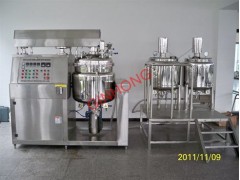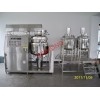Emulsifying machines help to stabilize emulsions. A popular emulsifier is the tenside, which is blended into one of the few phases prior to emulsifying. A typical emulsifier is one part hydrophilic or water-loving, and another part lipophilic or fat-loving.
One side of the molecule of emulsifier bonds with water and another side bonds with oil. During this procedure, the emulsifying machine is able to stabilize the created droplets, with the result being a counteraction of the potential separation of emulsion. In fact, many advanced and innovative mixing methods for emulsification have been developed in order to produce different types of emulsions.
In low speed (ultra-low shear) mode, emulsifying machines use the principle of inter-cavity transfer to gently cut and fold material in multiple planes for highly effective distributive mixing (blending). For viscous fluids, rubbers, plastics, pastes and doughs, the large rotor-stator gaps, low speeds and laminar flow regime means that very little shear is imparted to the material. This makes emulsifying mixer an excellent solution for blending delicate or shear-sensitive materials such as long-chain polymers, adhesives and structured food products.




 Company
Company